
| TSP Lab | SGA CDR Viewer | SgaCDRViewer.exe |
|---|
At program start-up the user must authenticate him/herself. The user name, password and usage reason must be given to log on.
The CDR types to be used can be selected before log on.

If the 'Apply default roles' is not checked, then the CDR viewer and remote capture roles can be set.
The user may log on without any remote capture permissions.
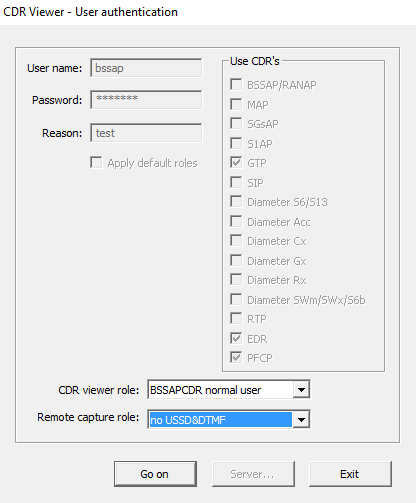
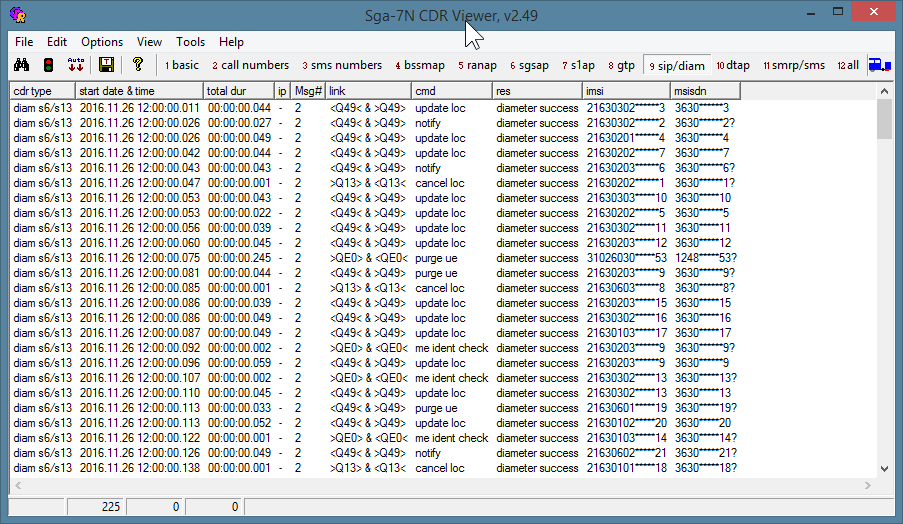
Each line in the main window represents a CDR. The CDR's are sorted by date and time by default. By clicking on a column header the CDR's can be sorted by the fields of that column. A second click sorts the CDR's in the reverse order. A third click restores the original sorting.
| Menu | Menuitem | Shortcut(s) | Meaning |
|---|---|---|---|
| [File] | Search in CDR database... | F8 | Open the Search in CDR database dialog window |
| Start searching | F9 | If the Search in CDR database dialog window is opened: start searching in CDR database
Otherwise: open the Search in CDR database dialog window | |
| Stop searching | Shift+F9 | Stop searching in CDR database | |
| Clear result list | Delete CDR's from the program's memory | ||
| Get CDR messages... | Ctrl+M | Open the Get CDR messages dialog window | |
| Get CDR messages of the current CDR | Ctrl+Shift+M | Open the Get CDR messages dialog window and start the remote capture | |
| Unveil sensitive data | Unveil the veiled pieces of information, such as IMSI, IMEI and various MSISDN's in the current, selected, or marked CDR's | ||
| Re-veil sensitive data | Re-veil the unveiled pieces of information in the current, selected, or marked CDR's | ||
| Save as text file... | Ctrl+Shift+S | Save the CDR's contents and the interpretation of the corresponding signaling messages in the various formats | |
| Re-authenticate... | Re-authenticate with possibly different parameters | ||
| Exit | Alt+F4 | Exit the program | |
| [Edit] / Copy | Copy current line | Ctrl+C or Ctrl+Ins | Copy the current line to the clipboard |
| Copy selected lines | Copy the selected lines to the clipboard | ||
| Copy marked lines | Copy the marked lines to the clipboard | ||
| Copy block of values... | Select and copy a block of values to the clipboard | ||
| [Edit] / Select | Invert selection | Numpad * | |
| Invert selection of the current item | Space | ||
| Select items after the current item | |||
| Select items before the current item | |||
| Select all the items | |||
| Set beginning of range | Ctrl+A | ||
| Select range | Ctrl+B | ||
| [Edit] / Unselect | Unselect all the items | Numpad / | |
| Unselect items after the current item | |||
| Unselect items before the current item | |||
| Unselect all the items | |||
| Set beginning of range | Ctrl+A | ||
| Unselect range | Ctrl+U | ||
| [Edit] / Mark | Invert markers | Shift + Numpad * | |
| Invert marker of the current item | Shift + Space | ||
| Mark selected items | Numpad + | ||
| Mark items after the current item | |||
| Mark items before the current item | |||
| Mark all the items | |||
| Set beginning of range | Ctrl+Shift+A | ||
| Mark range | Ctrl+Shift+B | ||
| [Edit] / Unmark | Unmark selected items | Numpad - | |
| Unmark items after the current item | |||
| Unmark items before the current item | |||
| Unmark all the items | |||
| Set beginning of range | Ctrl+Shift+A | ||
| Unmark range | Ctrl+Shift+U | ||
| [Edit] / Hide | Hide selected items | Ctrl+H | |
| Hide marked items | Ctrl+Shift+H | ||
| [Edit] / Keep | Keep selected items | Ctrl+K | |
| Keep marked items | Ctrl+Shift+K | ||
| [Edit] / Go to | Go to the first selected item | Ctrl+Home | |
| Go to the last selected item | Ctrl+End | ||
| Go to the next selected item | Ctrl+Down | ||
| Go to the previous selected item | Ctrl+Up | ||
| Go to the first marked item | Ctrl+Shift+Home | ||
| Go to the last marked item | Ctrl+Shift+End | ||
| Go to the next marked item | Ctrl+Shift+Down | ||
| Go to the previous marked item | Ctrl+Shift+Up | ||
| [Edit] | Find text... | Ctrl+F | Find text in the CDR list lines |
| Find next text | F3 | Find the next line that matches the text set in the Find text dialog window | |
| Find previous text | Shift+F3 | Find the previous line that matches the text set in the Find text dialog window | |
| Find expression... | Ctrl+E | Find specific CDR's in the CDR list using logical expressions | |
| Find next expression | F4 | Find the next CDR that matches the expression set in the Find expression dialog window | |
| Find previous expression | Shift+F4 | Find the previous CDR that matches the expression set in the Find expression dialog window | |
| [Options] | Auto scroll | Enable/disable auto-scrolling to the end of the CDR list while searching in the database | |
| Save window positions on exit | Save the positions of the main window and of some of the dialog windows on exit | ||
| Save positions and options to INI file | Save window positions and options to SgaCDRViewer.ini file now | ||
| Sort SIP CDRs | Sort SIP CDRs based on Call-Summary-ID and timestamp | ||
| Show RTP CDR Bins | Show the details of the Bins (values per second) in a list. | ||
| [View] | Customize current view... | F5 | Displays a dialog window to select columns for the current view |
| Save views to INI file | Save the column arrangement of all the views to SgaCDRViewer.ini file now | ||
| Reset all views | Reset views to their default arrangements | ||
| Select next view | Ctrl+Tab | Choose the next view to become visible if there is no dialog window open, or focus on the next window otherwise | |
| Select previous view | Ctrl+Shift+Tab | Choose the previous view to become visible if there is no dialog window open, or focus on the previous window otherwise | |
| Select view 1..9 | Ctrl+1 ... Ctrl+9 or text buttons in the tool bar | Choose which view to become visible. View columns can be selected in the Customize current view dialog window. | |
| [Tools] | Select items with CDR trace... | Ctrl+T | Select items with a CDR trace. The trace function selects all records, which match with the currently selected. The Trace type (GTP context, Diameter Session-ID, SIP CsID) defines the conditions of the selection. The GTP context trace is based on the IMSI, and the EBI and start time from the Context Session Info content. Diameter Session-ID trace is based on the Session-ID parameter. SIP CsID trace is based on the Call-Summary-ID parameter. |
| [Help] | How to use... | F1 | Show this help file |
| About... | Ctrl+F1 | Show copyright, program version and user authentication information |
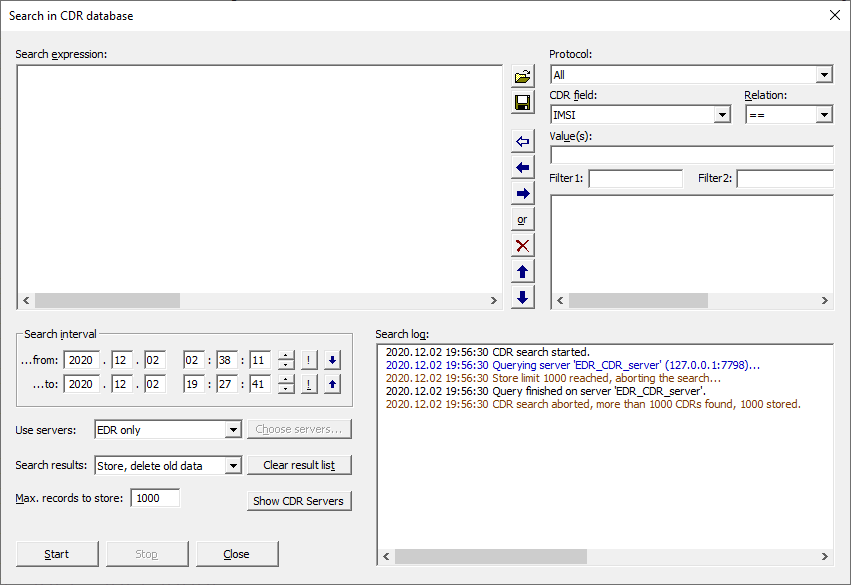
 or Ctrl+Up/Ctrl+Down: increment/decrement value at caret in the start/end time
or Ctrl+Up/Ctrl+Down: increment/decrement value at caret in the start/end time
 set current time as the start/end time
set current time as the start/end time
 or Ctrl+Shift+Down: copy the start time to the end time
or Ctrl+Shift+Down: copy the start time to the end time
 or Ctrl+Shift+Up: copy the end time to the start time
or Ctrl+Shift+Up: copy the end time to the start time
 or Alt+L: load filter (search) expression from file
or Alt+L: load filter (search) expression from file
 or Alt+S: save filter (search) expression to file
or Alt+S: save filter (search) expression to file
 or Alt+Enter: insert a new relation / add values to a relation in the search expression
or Alt+Enter: insert a new relation / add values to a relation in the search expression
 or Alt+Left: insert a new relation / replace selected values of a relation in the search expression
or Alt+Left: insert a new relation / replace selected values of a relation in the search expression
 or Alt+Right: copy relation with values from the selected expression lines
or Alt+Right: copy relation with values from the selected expression lines
 or Alt+O: insert an OR relation to the search expression
or Alt+O: insert an OR relation to the search expression
 or Alt+Delete or Delete: delete current/selected line(s) from the search expression
or Alt+Delete or Delete: delete current/selected line(s) from the search expression
 or Alt+Up: move up the current/selected line(s) from the search expression
or Alt+Up: move up the current/selected line(s) from the search expression
 or Alt+Down: move down the current/selected line(s) from the search expression
or Alt+Down: move down the current/selected line(s) from the search expression

| Field name | Value type | Used in CDR's |
|---|---|---|
| CDR type | decimal | all |
| Start date and time | date and time | all |
| Start time | time | all |
| End date and time | date and time | all except SGsAP and EDR |
| End time | time | all except SGsAP and EDR |
| Total duration | duration | all except SGsAP and EDR |
| Ctx/Session start date and time | grp date and time | Diam-Rx, SWm/SWx/S6b, PFCP, NGAP |
| Ctx/Session start time | grp time | Diam-Rx, SWm/SWx/S6b, PFCP, NGAP |
| Ctx/Session end date and time | grp date and time | Diam-Rx, SWm/SWx/S6b, PFCP, NGAP |
| Ctx/Session end time | grp time | Diam-Rx, SWm/SWx/S6b, PFCP, NGAP |
| Ctx/Session total duration | grp duration | Diam-Rx, SWm/SWx/S6b, PFCP, NGAP |
| Link name | Link ID (3 characters) | all except EDR |
| Number of transactions | decimal | GTP |
| Number of messages | decimal | all except RTP and EDR |
| IMSI | BCD number | all except (non-VoLTE) SIP and Diam-Acc |
| IMEI(SV) | BCD number | all except SIP, Diam-Acc and Diam-Rx |
| (P)TMSI | 8-digit hexadecimal | BSSAP, SGSAP, GTP |
| M-TMSI | 8-digit hexadecimal | S1AP, EDR, NGAP |
| MSISDN | TBCD number | all except SGSAP and S1AP |
| MSISDN (derived) | TBCD number | BSSAP, MAP, EDR |
| IP Address | IP address | S1AP, GTP, SIP, SIPCall, RTP, EDR, NGAP, SBI, DiamRx |
| User IP Address | IP address | GTP, EDR, PFCP |
| Access point name | APN text | BSSAP, GTP, S1AP, Diam-S6/S13, Diam-Gx (Called station ID), EDR, PFCP |
| Data Network Name | DNN text | NGAP, PCF, SBI |
| PDU Session ID | decimal | NGAP, PCF, SBI |
| MCC | MCC | BSSAP, SGSAP, GTP, SIP, SIPCall, EDR, NGAP, SBI, PCF |
| MCC_ECGI | MCC | SGSAP, GTP, SIP, SIPCall, EDR, SBI, PCF |
| MCC_TAI | MCC | SGSAP, GTP, SIPCall, EDR, SBI, PCF |
| MCC_RAI | MCC | GTP, SIPCall |
| MCC_SAI | MCC | GTP, SIP, SIPCall |
| MCC_CGI | MCC | GTP, SIP, SIPCall |
| MCC_ServNetw | MCC | GTP, SIPCall, SBI |
| MCC_UCGI | MCC | GTP, SIP, SIPCall |
| MNC | MNC | BSSAP, SGSAP, GTP, SIP, SIPCall, EDR, NGAP, SBI, PCF |
| MNC_ECGI | MNC | SGSAP, GTP, SIP, SIPCall, EDR, SBI, PCF |
| MNC_TAI | MNC | SGSAP, GTP, SIP, SIPCall, EDR, SBI, PCF |
| MNC_RAI | MNC | GTP, SIPCall |
| MNC_SAI | MNC | GTP, SIP, SIPCall |
| MNC_CGI | MNC | GTP, SIP, SIPCall |
| MNC_ServNetw | MNC | GTP, SIPCall, SBI |
| MNC_UCGI | MNC | GTP, SIP, SIPCall |
| LAC | 4-digit hexadecimal | BSSAP, SGSAP, GTP, SIP, SIPCall, EDR |
| CI | 4-digit hexadecimal | BSSAP, SGSAP, GTP, SIPCall |
| UCI | 7-digit hexadecimal | BSSAP, GTP, SIP, SIPCall |
| SAC | 4-digit hexadecimal | BSSAP, GTP, SIP, SIPCall |
| RAC | 2-digit hexadecimal | BSSAP, GTP, SIPCall |
| ECI | 7-digit hexadecimal | SGSAP, GTP, SIP, SIPCall, EDR, SBI, PCF |
| TAC | 4-digit hexadecimal | SGSAP, GTP, SIP, SIPCall, EDR, PCF, NGAP, SBI, PCF |
| NR CI | 9-digit hexadecimal | SGSAP, GTP, SIP, SIPCall, EDR, NGAP, PCF, SBI |
| BSSAP Reassembly status | decimal | BSSAP |
| M3UA Network indicator | decimal | BSSAP, MAP |
| M3UA Originating point code | decimal | BSSAP, MAP |
| M3UA Destination point code | decimal | BSSAP, MAP |
| M3UA Orig. point name (ni/opc) | decimal/decimal | BSSAP, MAP |
| M3UA Dest. point name (ni/dpc) | decimal/decimal | BSSAP, MAP |
| SCCP Message type | decimal | BSSAP, MAP |
| SCCP Source local ref. | 6-digit hexadecimal | BSSAP |
| SCCP Destination local ref. | 6-digit hexadecimal | BSSAP |
| SCCP Calling Party Address | TBCD number | MAP |
| SCCP Called Party Address | TBCD number | MAP |
| BSSMAP Message type | decimal | BSSAP |
| BSSMAP Cause | decimal | BSSAP |
| BSSMAP LCS cause | decimal | BSSAP |
| BSSMAP Return error cause | decimal | BSSAP |
| BSSMAP RR cause | decimal | BSSAP |
| BSSMAP Chosen EA | decimal | BSSAP |
| BSSMAP Circuit identity code | decimal | BSSAP |
| BSSLAP Cause | decimal | BSSAP |
| RANAP Procedure | decimal | BSSAP |
| RANAP Cause | decimal | BSSAP |
| RANAP Paging cause | decimal | BSSAP |
| RANAP Reject cause | decimal | BSSAP |
| SGsAP Message type | decimal | SGSAP |
| SGsAP SGs cause | decimal | SGSAP |
| SGsAP Reject cause | decimal | SGSAP |
| SGsAP Calling line ident. NP | decimal | SGSAP |
| SGsAP Calling line ident. TN | decimal | SGSAP |
| SGsAP Calling line ident. | TBCD number | SGSAP |
| SGsAP MME/VLR name | APN text | SGSAP |
| SGsAP Service indicator | decimal | SGSAP |
| S1AP Opening reason | decimal | S1AP |
| S1AP Closing reason | decimal | S1AP |
| S1AP Connection ID | decimal | S1AP |
| S1AP PDU Type | decimal | S1AP |
| S1AP Procedure Code | decimal | S1AP |
| S1AP MME-UE-S1AP-ID | 8-digit hexadecimal | S1AP |
| S1AP eNB-UE-S1AP-ID | 6-digit hexadecimal | S1AP, EDR |
| S1AP Cause | decimal pair | S1AP |
| S1AP RRC Establishment Cause value | decimal | S1AP |
| S1AP RRC Establishment Cause | decimal | S1AP |
| GTP Transaction opening reason | decimal | GTP |
| GTP Transaction closing reason | decimal | GTP |
| GTP Transaction ID | decimal | GTP |
| GTP TEID | 8-digit hexadecimal | GTP, PFCP |
| GTP RAT Type | decimal | GTP |
| GTP User IP | IP address | GTP, EDR |
| GTP Endpoint IP | IP address | GTP, PFCP |
| GTP STN-SR | TBCD number | GTP |
| GTP EBI | decimal | GTP, EDR |
| GTP Information Elements | text | GTP |
| GTP0-C Message type | decimal | GTP |
| GTP0-C Cause | decimal | GTP |
| GTP0-C IE ID | decimal | GTP |
| GTP0-C IE ID and Value | text | GTP |
| GTP1-C Message type | decimal | GTP |
| GTP1-C Cause | decimal | GTP |
| GTP1-C IE ID | decimal | GTP |
| GTP1-C IE ID and Value | text | GTP |
| GTP2-C Message type | decimal | GTP |
| GTP2-C Cause | decimal | GTP |
| GTP2-C SRVCC Cause | decimal | GTP |
| GTP2-C Up Function Ind Flag | decimal | GTP |
| GTP2-C Secondary RAT Usage UL | decimal | GTP |
| GTP2-C Secondary RAT Usage DL | decimal | GTP |
| GTP2-C IE ID | decimal | GTP |
| GTP2-C IE ID and Value | text | GTP |
| GTP Context ID | decimal | GTP |
| GTP Context opening reason | decimal | GTP |
| GTP Context closing reason | decimal | GTP |
| GTP-Sv Tr summary type | decimal | GTP |
| GTP-Sv Tr summary opening reason | decimal | GTP |
| GTP-Sv Tr summary closing reason | decimal | GTP |
| SIP Transaction opening reason | decimal | SIP, SIPCall |
| SIP Transaction closing reason | decimal | SIP, SIPCall |
| SIP Transaction ID | decimal | SIP, SIPCall |
| SIP Transaction type | decimal | SIP |
| SIP Method | decimal | SIP, SIPCall |
| SIP Status | decimal | SIP, SIPCall |
| SIP CSeq Method | decimal | SIP, SIPCall |
| SIP Call-ID | text | SIP, SIPCall |
| SIP IMS Charging ID | text | SIP, SIPCall |
| SIP IMS Charging ID (Related) | text | SIP, SIPCall |
| SIP From MSISDN | MSISDN number | SIP, SIPCall |
| SIP From IMPI | text | SIP |
| SIP To MSISDN | MSISDN number | SIP, SIPCall |
| SIP To IMPI | text | SIP |
| SIP Forwarded to MSISDN | MSISDN number | SIP, SIPCall |
| SIP User Agent | text | SIP, SIPCall |
| SIP Reason Protocol | decimal | SIP |
| SIP Reason Cause | decimal | SIP |
| SIP Reason Text | text | SIP |
| SIP Reason Warning | text | SIP |
| SIP PANI Acces Class | decimal | SIP |
| SIP PANI Access Info | decimal | SIP |
| SIP Call Summary opening reason | decimal | SIP |
| SIP Call Summary closing reason | decimal | SIP |
| SIP Call Summary ID | decimal | SIP |
| SIP Call Summary ID (Related) | decimal | SIP |
| SIP Call Summary start date and time | date and time | SIP |
| SIP Call Summary start time | time | SIP |
| SIP Source IP Address | IP Address | SIP, SIPCall |
| SIP Destination IP Address | IP Address | SIP, SIPCall |
| SIPCall Refer-To MSISDN | MSISDN number | SIP, SIPCall |
| SIPCall Original Calling Number | MSISDN number | SIP, SIPCall |
| SIPCall Number of conf. part. | decimal | SIP, SIPCall |
| SIPCall Call Connected duration | time | SIP, SIPCall |
| Diameter Command | decimal | Diam-S6/S13, Diam-Acc, Diam-Cx, Diam-Gx, Diam-Rx |
| Diameter Session ID | text | Diam-S6/S13, Diam-Acc, Diam-Cx, Diam-Gx, Diam-Rx |
| Diameter Origin host | text | Diam-S6/S13, Diam-Acc, Diam-Cx, Diam-Gx, Diam-Rx |
| Diameter Origin realm | text | Diam-S6/S13, Diam-Cx, Diam-Gx, Diam-Rx |
| Diameter Destination host | text | Diam-S6/S13, Diam-Cx, Diam-Gx, Diam-Rx |
| Diameter Destination realm | text | Diam-S6/S13, Diam-Acc, Diam-Cx, Diam-Gx, Diam-Rx |
| Diameter Result (3GPP) | decimal | Diam-S6/S13, Diam-Acc, Diam-Cx, Diam-Gx, Diam-Rx |
| Diameter Experimental result | decimal | Diam-S6/S13, Diam-Acc, Diam-Cx, Diam-Gx, Diam-Rx |
| Diameter RAT type | decimal | Diam-S6/S13, Diam-Rx |
| Diameter Server assignment type | decimal | Diam-S6/S13, Diam-Rx |
| Diameter Termination cause | decimal | Diam-S6/S13, Diam-Rx |
| Diameter Transaction closing reason | decimal | Diam-S6/S13, Diam-Rx |
| Diameter Session opening reason | decimal | Diam-S6/S13, Diam-Rx |
| Diameter Session closing reason | decimal | Diam-S6/S13, Diam-Rx |
| Diameter Request Message count | decimal | Diam-S6/S13, Diam-Rx |
| Diameter Answer Message count | decimal | Diam-S6/S13, Diam-Rx |
| Diam-S6/S13 Equipment status | decimal | Diam-S6/S13 |
| Diam-Acc Accounting record type | decimal | Diam-Acc |
| Diam-Acc Role of node | decimal | Diam-Acc |
| Diam-Acc Subscription ID type | decimal | Diam-Acc |
| Diam-Acc Subscription ID data | text | Diam-Acc |
| Diam-Acc Calling party address | text | Diam-Acc |
| Diam-Acc Dialled party address | text | Diam-Acc |
| Diam-Acc Called party address | text | Diam-Acc |
| Diam-Acc SIP Method | text | Diam-Acc |
| Diam-Acc SIP Request date and time | date and time | Diam-Acc |
| Diam-Acc SIP Request time | time | Diam-Acc |
| Diam-Acc SIP Response date and time | date and time | Diam-Acc |
| Diam-Acc SIP Response time | time | Diam-Acc |
| Diam-Acc IMS charging ID | text | Diam-Acc |
| Diam-Acc Cause code | decimal | Diam-Acc |
| Diam-Cx User name | text | Diam-Cx |
| Diam-Cx Public identity | text | Diam-Cx |
| Diam-Cx User authorization type | decimal | Diam-Cx |
| Diam-Gx user-defined req AVP's | text | Diam-Gx |
| Diam-Gx user-defined ans AVP's | text | Diam-Gx |
| Diam-Gx/Rx user-defined AVP's | text | Diam-Gx, Diam-Rx |
| Diam-Gx CC request type | decimal | Diam-Gx |
| Diam-Gx Re-auth request type | decimal | Diam-Gx |
| Diam-Gx Called station ID | text | Diam-Gx |
| Diam-Gx/Rx Framed IP address | IPv4 address | Diam-Gx, Diam-Rx |
| Diam-Gx/Rx Framed IPv6 prefix | IPv6 prefix | Diam-Gx, Diam-Rx |
| Diam-Rx Transaction closing reason | decimal | Diam-Rx |
| Diam-Rx Session opening reason | decimal | Diam-Rx |
| Diam-Rx Session closing reason | decimal | Diam-Rx |
| Diam-Rx Session type | decimal | Diam-Rx |
| Diam-SWm UE Local IP Address | IPv4 address | Diam-Swm |
| Diam-SWm Authorization Lifetime | decimal | Diam-Swm |
| Diam-SWm Auth Grace Period | decimal | Diam-Swm |
| Diam-S6b MIP6 Feature Vector | decimal | Diam-S6b |
| Diam-VoWifi Auth Request Type | decimal | Diam-VoWifi |
| Diam-VoWifi MIP Home Agent Address | IP address | Diam-VoWifi |
| Diam-VoWifi Service Selection | text | Diam-VoWifi |
| DTAP Protocol discriminator | decimal | BSSAP, SGSAP |
| DTAP-RR Message type | decimal | BSSAP, SGSAP |
| DTAP-RR RR cause | decimal | BSSAP, SGSAP |
| DTAP-RR Suspension cause | decimal | BSSAP, SGSAP |
| DTAP-RR Handover reference | decimal | BSSAP |
| DTAP-MM Message type | decimal | BSSAP, SGSAP |
| DTAP-MM Reject cause | decimal | BSSAP, SGSAP |
| DTAP-CC Message type | decimal | BSSAP, SGSAP |
| DTAP-CC Cause | decimal | BSSAP, SGSAP |
| DTAP-CC Cause of no CLI | decimal | BSSAP, SGSAP |
| DTAP-CC Calling party num. NP | decimal | BSSAP |
| DTAP-CC Calling party num. TN | decimal | BSSAP |
| DTAP-CC Calling party num. | TBCD number | BSSAP |
| DTAP-CC Called party num. NP | decimal | BSSAP |
| DTAP-CC Called party num. TN | decimal | BSSAP |
| DTAP-CC Called party num. | TBCD number | BSSAP |
| DTAP-CC Redirecting num. NP | decimal | BSSAP |
| DTAP-CC Redirecting num. TN | decimal | BSSAP |
| DTAP-CC Redirecting num. | TBCD number | BSSAP |
| DTAP-GMM Message type | decimal | BSSAP, SGSAP |
| DTAP-GMM Cause | decimal | BSSAP, SGSAP |
| DTAP-SM Message type | decimal | BSSAP, SGSAP |
| DTAP-SM Cause | decimal | BSSAP, SGSAP |
| DTAP-SM AA Deactivation cause | decimal | BSSAP, SGSAP |
| DTAP-SS Message type | decimal | BSSAP, SGSAP |
| DTAP-SS Cause | decimal | BSSAP, SGSAP |
| DTAP-SMS Message type | decimal | BSSAP, SGSAP |
| DTAP-SMS Cause | decimal | BSSAP, SGSAP |
| DTAP-EMM Message type | decimal | S1AP |
| DTAP-EMM Cause | decimal | S1AP |
| DTAP-ESM Message type | decimal | S1AP |
| DTAP-ESM Cause | decimal | S1AP |
| TCAP Message type | decimal | MAP |
| TCAP OTID | 4-digit hexadecimal | MAP |
| TCAP DTID | 4-digit hexadecimal | MAP |
| MAP Release Cause | decimal | MAP |
| MAP Component type | decimal | MAP |
| MAP Invoke ID | decimal | MAP |
| MAP Operation Name | decimal | MAP |
| MAP Error Code | decimal | MAP |
| (X)UDTS Return Cause | decimal | MAP |
| INAP Operation Name | decimal | MAP |
| RTP RecordType | decimal | RTP |
| RTP Transaction ID | decimal | RTP |
| RTP Flow ID | decimal | RTP |
| RTP Type | decimal | RTP |
| RTP Session Type | text | RTP |
| RTP isCore | decimal | RTP |
| RTP isDTMF | decimal | RTP |
| RTP isPTimeError | decimal | RTP |
| RTP isPayloadTypeMismatch | decimal | RTP |
| RTP State | decimal | RTP |
| RTP Problem Count | decimal | RTP |
| RTP QoE AVG | double | RTP |
| RTP QoE Min | double | RTP |
| RTP QoE Max | double | RTP |
| RTP QoE Sd | double | RTP |
| RTP QoE N | double | RTP |
| RTP Missing Flow | decimal | RTP |
| RTP OneWayAudio | decimal | RTP |
| RTP PayloadTypeConflict | decimal | RTP |
| RTP MaxLossRatio | double | RTP |
| RTP AMRModes | decimal | RTP |
| RTP FinalQoE | double | RTP |
| RTP FlowType | decimal | RTP |
| EDR SMGR Number | decimal | EDR |
| EDR Sequence Number | decimal | EDR |
| EDR Event Identity | decimal | EDR |
| EDR Result | decimal | EDR |
| EDR GUTI Type | decimal | EDR |
| EDR Disc Reason | decimal | EDR |
| EDR PDN Type | decimal | EDR |
| EDR PTI | decimal | EDR |
| EDR QCI | decimal | EDR |
| EDR ARP | decimal | EDR |
| EDR QoS Change | decimal | EDR |
| PFCP Message type | decimal | PFCP |
| PFCP Context opening reason | decimal | PFCP |
| PFCP Context closing reason | decimal | PFCP |
| PFCP Transaction opening reason | decimal | PFCP |
| PFCP Transaction closing reason | decimal | PFCP |
| PFCP Squence Number | decimal | PFCP |
| PFCP SEID | hexadecimal | PFCP |
| PFCP Cause | decimal | PFCP |
| PFCP Endpoint IP | IP address | PFCP |
| PFCP Traffic Endpoint IP | decimal | PFCP |
| PFCP Information Elements | text | PFCP |
| NGAP Opening reason | decimal | NGAP |
| NGAP Closing reason | decimal | NGAP |
| NGAP Connection ID | decimal | NGAP |
| NGAP PDU Type | decimal | NGAP |
| NGAP Procedure Code | decimal | NGAP |
| NGAP AMF-UE-NGAP-ID | hexadecimal | NGAP |
| NGAP RAN-UE-NGAP-ID | hexadecimal | NGAP |
| NGAP Cause value | decimal | NGAP |
| NGAP Cause | decimal | NGAP |
| NGAP RRC Establishment Cause vaule | decimal | NGAP |
| NGAP RRC Establishment Cause | decimal | NGAP |
| NGAP PDU Session ID | decimal | NGAP |
| NGAP SST | decimal | NGAP |
| NGAP Context opening reason | decimal | NGAP |
| NGAP Context closing reason | decimal | NGAP |
| 5GS Registration Type | decimal | NGAP |
| 5GS Follow-on Request Pending | decimal | NGAP |
| NAS-MM Message Type | decimal | NGAP |
| 5GMM Cause | decimal | NGAP |
| NAS-SM Message Type | decimal | NGAP |
| 5GSM Cause | decimal | NGAP |
| NAS-SM PDU Session Type | decimal | NGAP |
| SBI Opening reason | decimal | SBI |
| SBI Closing reason | decimal | SBI |
| SBI Interface | decimal | SBI |
| SBI StreamID | decimal | SBI |
| SBI TransactionID | decimal | SBI |
| SBI AMF ID | hexadecimal | SBI |
| SBI RAT Type | text | SBI |
| SBI Result | text | SBI |
| SBI Cause | text | SBI |
| SBI Status | text | SBI |
| HTTP2 Method | text | NGAP, SBI, PCF |
| HTTP2 Status Code | text | NGAP, SBI, PCF |
| HTTP2 Path | text | NGAP, SBI, PCF |
| HTTP2 Location | text | NGAP, SBI, PCF |
| Cloud Cluster ID | text | NGAP, SBI, PCF |
| Cloud Pod ID | text | NGAP, SBI, PCF |
| Cloud Source ID | text | NGAP, SBI, PCF |
| Cloud Destination ID | text | NGAP, SBI, PCF |
| PCF Message Type | decimal | PCF |
| PCF Record Type | text | PCF |
| PCF Opening reason | decimal | PCF |
| PCF Closing reason | decimal | PCF |
| PCF Operation Type | decimal | PCF |
| PCF SM Policy ID | text | PCF |
| PCF Result Code | decimal | PCF |
| PCF RATType | text | PCF |
| PCF JSON | text | PCF |
| SMRP Message type | decimal | BSSAP, SGSAP, S1AP |
| SMRP Cause | decimal | BSSAP, SGSAP, S1AP |
| SMRP Originator address NP | decimal | BSSAP, SGSAP, S1AP |
| SMRP Originator address TN | decimal | BSSAP, SGSAP, S1AP |
| SMRP Originator address | TBCD number | BSSAP, SGSAP, S1AP |
| SMRP Destination address NP | decimal | BSSAP, SGSAP, S1AP |
| SMRP Destination address TN | decimal | BSSAP, SGSAP, S1AP |
| SMRP Destination address | TBCD number | BSSAP, SGSAP, S1AP |
| SMS Message type | decimal | BSSAP, SGSAP, S1AP |
| SMS Failure cause | decimal | BSSAP, SGSAP, S1AP |
| SMS Originating address NP | decimal | BSSAP, SGSAP, S1AP |
| SMS Originating address TN | decimal | BSSAP, SGSAP, S1AP |
| SMS Originating address | text | BSSAP, SGSAP, S1AP |
| SMS Destination address NP | decimal | BSSAP, SGSAP, S1AP |
| SMS Destination address TN | decimal | BSSAP, SGSAP, S1AP |
| SMS Destination address | text | BSSAP, SGSAP, S1AP |
| SMS Recipient address NP | decimal | BSSAP, SGSAP, S1AP |
| SMS Recipient address TN | decimal | BSSAP, SGSAP, S1AP |
| SMS Recipient address | text | BSSAP, SGSAP, S1AP |
The '*' stands for zero or more digits/characters, the '?' stands for exactly one digit/character, the '.' stands for zero or one digit/character. To quote a wildcard character, use '\' (backslash).
Derived and non-derived numbers can be searched distinctively by ending the search expression with '?' or '!'. An ending '?' causes the search to find derived numbers only, while '!' finds non-derived ones only. In order to distinguish between the two meanings of '?', a terminating backslash can be used to indicate that it is used as a substitution symbol. (This is needed for subscriber numbers only.)
Here are some examples for values with wildcards and some corresponding matching strings (the lists are not exhaustive!):
| Subscriber number value | Matching numbers |
|---|---|
| 3630* | 3630, 36301, 363012, 3630123, 3630123? |
| 3630*9 | 36309, 363019, 3630129, 36301239, 36301239? |
| 3630*9* | 36309, 363019, 3630129, 36301291, 36301292, 36301292? |
| 3630?\ | 36301, 36302, 36303, 36303? |
| 3630?9 | 363019, 363029, 363039, 363039? |
| 3630?9? | 3630195, 3630295, 3630396, 3630396? |
| 3630. | 3630, 36301, 36301? |
| 3630.9 | 36309, 363019, 363019? |
| 3630.9. | 36309, 363019, 363092, 3630192, 3630192? |
| 36301234567 | 36301234567, 36301234567? |
| 36301234567? | 36301234567? |
| 36301234567! | 36301234567 |
| Text value | Matching strings |
|---|---|
| telekom.hu | telekom.hu, telekomhu, telekomxhu |
| telekom\.hu | telekom.hu |
| telekom? | telekom1, telekom2, telekom? |
| telekom\? | telekom? |
| telekom* | telekom, telekom1, telekom*, telekom.hu |
| telekom\* | telekom* |
Text values with special characters (e.g. space, comma, parentheses, quotation mark) must be enclosed in quotation marks. The backslash can be used as an escape character for the quotation mark ('\"') and for the backslash itself ('\\').
Here are some examples for text values with special characters and the corresponding matching strings:
| Text value (e.g. SIP Call-ID) | Matched string |
|---|---|
| "Apple\"Mac" | Apple"Mac |
| "Apple\\Mac" | Apple\Mac |
| "Apple,Mac" | Apple,Mac |
| "Apple Mac" | Apple Mac |
| "(Apple,Mac)" | (Apple,Mac) |
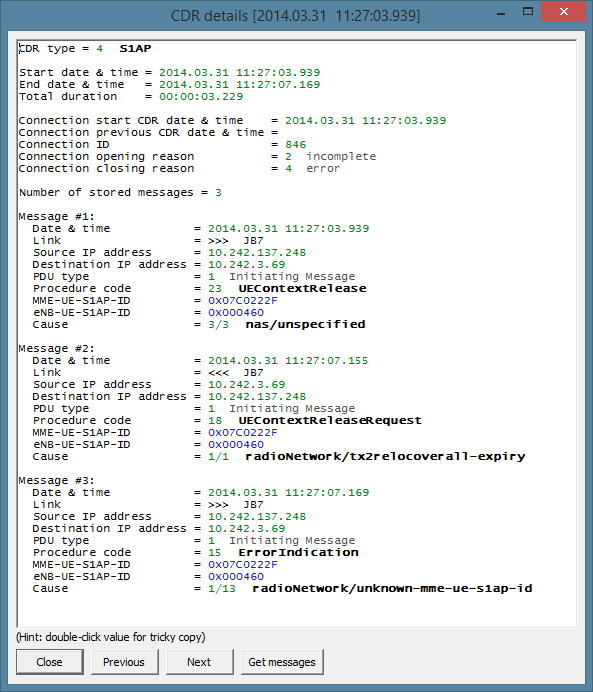
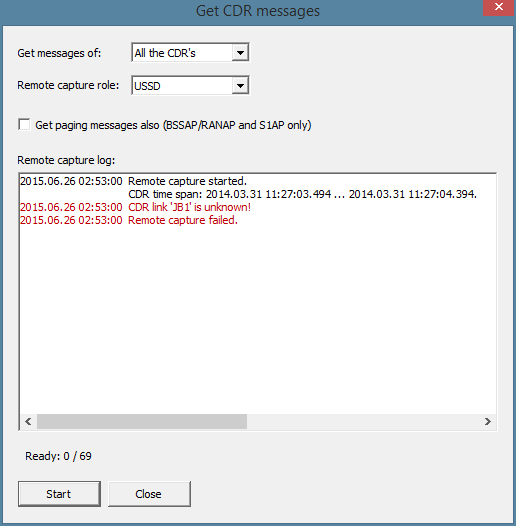
A new item can be added to the Columns list by selecting an item in the Values list box and pressing the push button Add. To remove a column in the main window, select the corresponding item in the Columns list box and press Remove. The position of a column can be changed by selecting the corresponding item in the Columns list box and pressing Move Up or Move Down as many times as needed.
The Column type settings determine how the columns appear in the main window. If an item in Columns has the column type Joined then a new column is started in the main window. If an item has the type Next, then the value will appear in the same column as the previous one.
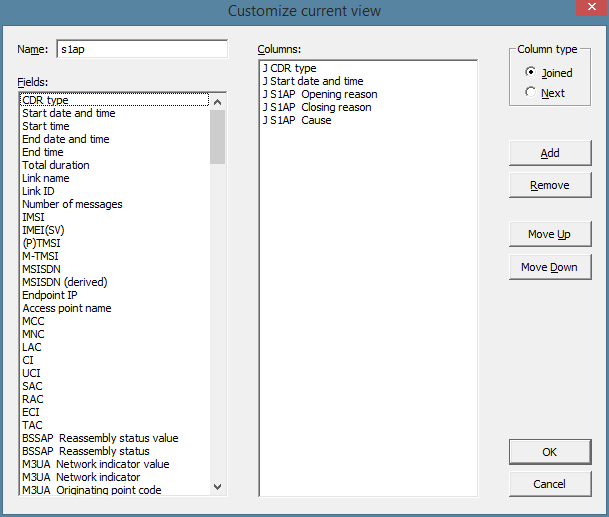
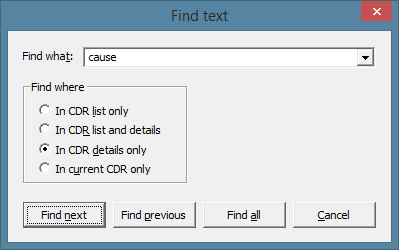
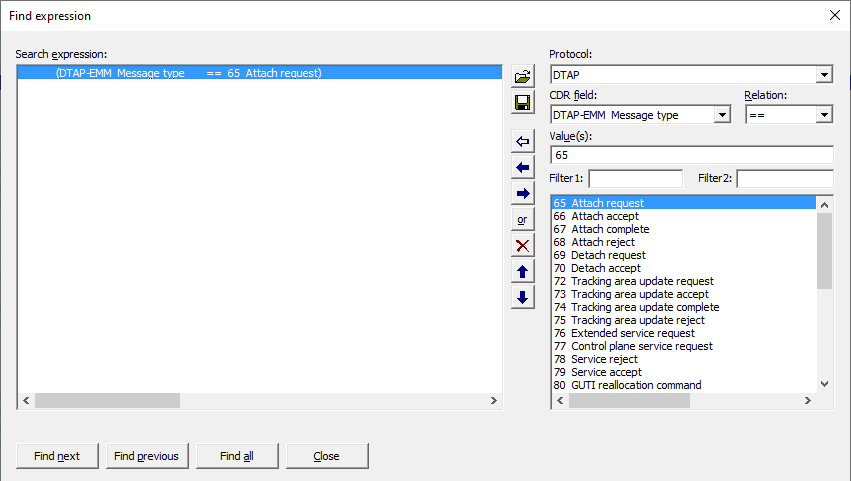
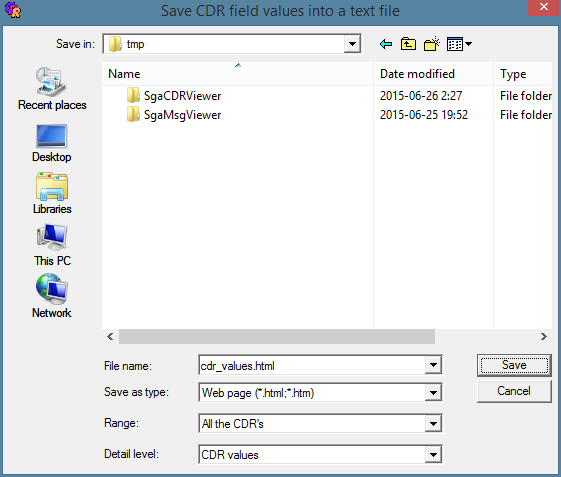
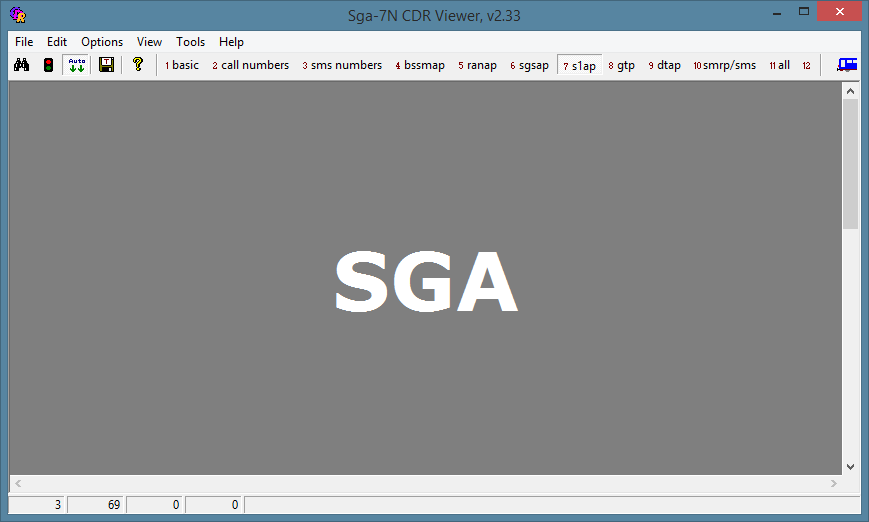
When the user is not active for 10 minutes then the program's main window goes blank and the open dialogs will be hidden. In case of user activity (mouse movement or keyboard stroke) the program displays a user verification dialog. The user has to enter the password in order to unlock the application. If the password is not correct then 2 more trials are allowed. After 3 unsuccesful trial the application closes.
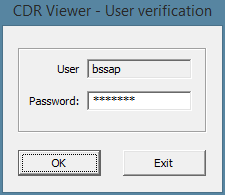
When there is no server activity (CDR query or remote capture) for 60 minutes then the application closes its connection to the authorizer modul and the user has to log on when he/she wants to get data from the query servers or monitors again.
Configuration files
INI file
The program uses the SgaCDRViewer.ini file located in the Windows directory to load/save various settings.
(Actually the base name of the INI file is the same as that of the program EXE file.)
| Section | Entry | Example | Meaning |
|---|---|---|---|
| [Position] | posMain | 807 159 1767 872 1 -1 -1 | position of the main window on the screen |
| iRCLeft | 140 | Relative X position of the Get messages dialog window on the screen | |
| iRCTop | 72 | Relative Y position of the Get messages dialog window on the screen | |
| iCdrDetailsLeft | 140 | Relative X position of the CDR details dialog window on the screen | |
| iCdrDetailsTop | 72 | Relative Y position of the CDR details dialog window on the screen | |
| iCdrDetailsWidth | 995 | Width of the CDR details dialog window on the screen | |
| iCdrDetailsHeight | 694 | Height of the CDR details dialog window on the screen | |
| iFindTextLeft | 100 | Relative X position of the Find text dialog window on the screen | |
| iFindTextTop | 100 | Relative Y position of the Find text dialog window on the screen | |
| iFindExprLeft | 100 | Relative X position of the Find expression dialog window on the screen | |
| iFindExprTop | 100 | Relative Y position of the Find expression dialog window on the screen | |
| iFindExprHeight | 100 | Height of the Find expression dialog window on the screen | |
| iSearchDBLeft | 100 | Relative X position of the Search in CDR database dialog window on the screen | |
| iSearchDBTop | 100 | Relative Y position of the Search in CDR database dialog window on the screen | |
| iSearchDBHeight | 100 | Height of the Search in CDR database dialog window on the screen | |
| [FileHistory] | File history | ||
| [FindText] | Find text settings and history | ||
| [SearchDB] | Settings and history in the Search in CDR database dialog window | ||
| [FindExpr] | sExpr | The last expression in the Find expression dialog window | |
| [Options] | bAutoScroll | True | See the menu item Options/Auto Scroll |
| bSaveWinPosOnExit | False | See the menu item Options/Save window positions on exit | |
| iRTPBinsGrpSec | 6 | Group the RTP Bins based on this value. The range of the value is 1 - 60. | |
| [CdrDetailOptions] | bSyntaxHilight | True | if true then colors and boldness are used to enhance readability of the text in the CDR details dialog window |
| bShowMsgPos | False | if true then the message position is also displayed in the CDR details dialog window | |
| iIndentSize | 2 | Indent (tabulator) size in characters in the CDR details dialog window | |
| iNRILength | 5 | TMSI / 'Network Resource Identifier' length in bits; zero length means no NRI (in the CDR details dialog window) | |
| [Advanced] | sServerIPAddress | 22.111.30.83 | The IP address of the authentication server |
| sDATFileCellNames | CellNames.csv | Data file needed for displaying names for MCC/MNC/LAC/CI | |
| sDATFileSANames | SANames.csv | Data file needed for displaying names for MCC/MNC/LAC/SAC | |
| sDATFileSigPointNames | SigPointNames.csv | Data file needed for displaying the signaling point names | |
| sDATFileIPAddrNames2 | IPAddrNames2.csv | Data file needed for displaying the IP address names | |
| sDATFileCIC2TermID | CIC2TermID.lst | Data file needed for displaying the GCP Termination ID for the BSSMAP CIC | |
| sLastCdrFilterPath | C:\Temp\test1.CdrFilt | Last filter file selected in the Save CDR filter or Load CDR filter dialog window | |
| sSaveAsText_Path | xy.htm | The path of the file in the Save CDR field values into a text file dialog window | |
| sSaveAsText_Format | HTML | The value of the 'Save as type' in the Save CDR field values into a text file dialog window | |
| sSaveAsText_Detail | VD | The value of the 'Detail level' in the Save CDR field values into a text file dialog window | |
| sSearchToFile_Path | xy.htm | The path of the file in the Write CDR search results into a text file dialog window | |
| sSearchToFile_Format | HTML | The value of the 'Save as type' in the Write CDR search results into a text file dialog window | |
| sSearchToFile_Detail | VD | The value of the 'Detail level' in the Write CDR search results into a text file dialog window | |
| uMaxRecords | 2000 | The value of the 'Max. records to store' in the Search in CDR database dialog window | |
| bStopAtLimit | False | The value of the 'Stop when limit is reached' in the Search in CDR database dialog window | |
| bSearchToFile | False | The value of the 'Save to file' in the Search in CDR database dialog window | |
| [RC] | bGetPagingMsg | False | The last state of the 'Get paging messages also' check box in the 'Get CDR messages' dialog window |
| [Authentication] | sUserName | obama | The last logged-in user |
| bApplyDefaultRoles | False | The last state of the 'Apply default roles' check box | |
| uCdrViewerRole | False | The last state of the 'CDR viewer role' combo box | |
| uRemoteCapRole | False | The last state of the 'Remote capture role' combo box | |
| bAllowMultipleCLI | False | Allow multiple command line instances in parallel |
Cell names file
The CellNames.csv file contains the cell names for the MCC/MNC/LAC/CI values.
There are 4 different data line types:
Service area names file
The SANames.csv file contains the service area names for the MCC/MNC/LAC/SAC values.
Each data line must containt all the values (MCC, MNC, LAC and SAC). The text in the 'Name' column will be displayed for the corresponding values.
Empty lines are skipped.
All numbers in the file are interpreted as hexadecimal numbers. Service area names can be up to 53 characters long.
Signaling point names file
The SigPointNames.csv file contains the signaling point names for the MTP/M3UA NI,DPC/OPC values.
If the NI+DPC or NI+OPC values in a MTP/M3UA message is found in the CSV file, then the signaling point name in the first matching item will be displayed.
All numbers in the file are interpreted as decimal numbers. Signaling point names can be up to 55 characters long.
IP address names file
The IPAddrNames2.csv file contains the IP address names for the IP addresses in various protocols.
Each row in the file has 4 columns separated by a comma. Only the first and the last columns are used by the Message Viewer.
The first column contains the IP address or an address range. The IP address can be an IPv4 or an IPv6 address. IPv6 addresses cannot use the mixed IPv6-IPv4 notation. IPv6 addresses may contain dots instead of colons (as a special 'SGA' format).
A single IP address can be followed by the prefix size.
An IP address range contains 2 addresses connected by a '-' char.
The last column contains the display name, which can be up to 55 characters long.
Comment lines start with a semicolon.
BSSMAP CIC to GCP Termination ID file
The CIC2TermID.lst file contains the necessary information to calculate the GCP Termination ID related to the { OPC, DPC, BSSMAP CIC } value triplet.
If the related GCP Termination ID can be determined, then it is displayed under the CIC value.
All numbers in the file are interpreted as decimal numbers.
Command Line Parameters
The SgaCDRViewer software could be started directly from command line, without the graphical user interface.
Using the following command line parameters, the user could successfully authenticate and search in the CDR databases.
To start a new search from command line, a CDRViewer specific search expression file (.CdrFilt filter file) must be loaded.
This filter file should be prepared with the graphical editor of the SgaCDRViewer.
Since using from command line could be an unsafe procedure, the program grants that only one search can be started per PC.
The order of the parameters is not predefined.
When one parameter appears more times, the program takes the last one into account.
| Command | Example parameter | Meaning | Condition |
|---|---|---|---|
| -h | Information about the available parameters | Optional | |
| -u | testuser | Username | Mandatory |
| -p | t3stp4ssw0rd | Password | Mandatory |
| -r | "Login reason" | Login reason phrase | Mandatory |
| -vr | normal | Viewer role. Possible values: normal, power. When the parameter is missing, the program loads it from the ini file. If the ini file is missing, the default parameter is normal. | Optional |
| -cr | 0 | Capture role. Possible values: 0-3 0 - no USSD&DTMF 1 - USSD 2 - DTMF 3 - USSD&DTMF When the parameter is missing, the program loads it from the ini file. If the ini file is missing, the default parameter is 0. | Optional |
| -ct | BSSAP,SGsAP,S1AP,GTP,SIP,S6,Acc,Cx,Gx,Rx | CDR Server Type This parameter is used to select the requested CDR databases based on the protocol name(s) during the authentication procedure. If the task is not allowed for the user, the requested AppCode and the name of the protocol is also logged into the log file. After a successful authentication, the defined parameter value is also used to select the Query servers, if the filter file does not this information. Using the "ALL" keyword will select ALL available CDR Servers. Using only one protocol name will select all available Query servers for the defined protocol. To select only BSSAP_CS or BSSAP_PS Query servers, the -ct BSSAP_CS or -ct BSSAP_PS parameters must be used. In this case, the software will authenticate for BSSAP/RANAP CDRs, all BSSAP_CS or all BSSAP_PS Query servers will be selected. | Mandatory |
| -f | D:/filterFilePath/search.CdrFilt | Search expression file path | Mandatory |
| -o | sga | Output file type. Possible parameters: sga, txt | Mandatory |
| -v | 3 | View number. Possible values: 1-12 The parameter is used to change the view during the "save as text" process. If the output type is text, and the parameter is missing, the program loads the default view from ini file. If the ini file is not available, the default value is 1. | Optional |
| -t | 1 | Text separator Possible values: 1-3 1 - Tab 2 - csv(comma) 3 - csv(semicolon) The parameter is used to define the text separator character in the output file, if it is text. When the parameter is missing, the default value is 1. | Optional |
| -d | 1 | Search to text file detail level. Possible values: 1-2 1 - Values 2 - CDR Details When the parameter is missing the default value is 1. | Optional |
| -out | D:/test/searchResult.sga | Output file path | Mandatory |
| -s | 1 | Sort the messages, when the output type is sga file format. Possible values: 0-1 0 - Do not sort 1 - Sort When the parameter is missing the default value is 0. | Optional |
| -op | 1 | Open the output sga file automatically. Possible values: 0-1 0 - Do not open 1 - Open automatically When the parameter is missing the default value is 0. | Optional |
| -l | d:/LogFiles/SgaCDRViewer.log | Log file path | Mandatory |
| -m | 1000 | Maximum records to store. When the parameter is missing then [INI]/[Advanced]/uMaxRecords is applied. It could be used only in save-as-text mode. | Optional |
If the first link in the CDR is a paging link then the corresponding link name is used to determine which MME/MSS/SGSN initiated the paging, and the relevant paging links are searched only.
Relevant means that the core equipment type with its one or two suffix number match with that of the first link.
Examples:
"MSS1A" matches "MSS1B" but it matches neither "MSS2A" nor "MSB1A".
"vMME01" matches "vMME01" but it matches neither "vMME0" nor "vMME02".
The search has a time interval of 2000 milliseconds, starting from the timestamp of the paging message stored in the CDR. Once the candidate messages are downloaded, the unneeded ones are sorted out by IMSI, TMSI and Cell ID.
For the search, the DPC and OPC are set as a filter, and the message timestamps in the CDR are used to determine one or more search intervals. Once the candidate messages are downloaded, the unneeded ones are sorted out by the SLR/DLR and by the timestamps.
If the first link in the CDR is a paging link then the corresponding link name is used to determine which MME initiated the paging, and the relevant paging links are searched only.
Relevant means that the core equipment type with its one or two suffix number match with that of the first link.
Example:
"MME1" matches "MME1" but it matches neither "MME2" nor "MME01".
"vMME01" matches "vMME01" but it matches neither "vMME0" nor "vMME02".
For the search, the message timestamps in the CDR are used to determine the search interval. Once the candidate messages are downloaded, the unneeded ones are sorted out by the timestamp.